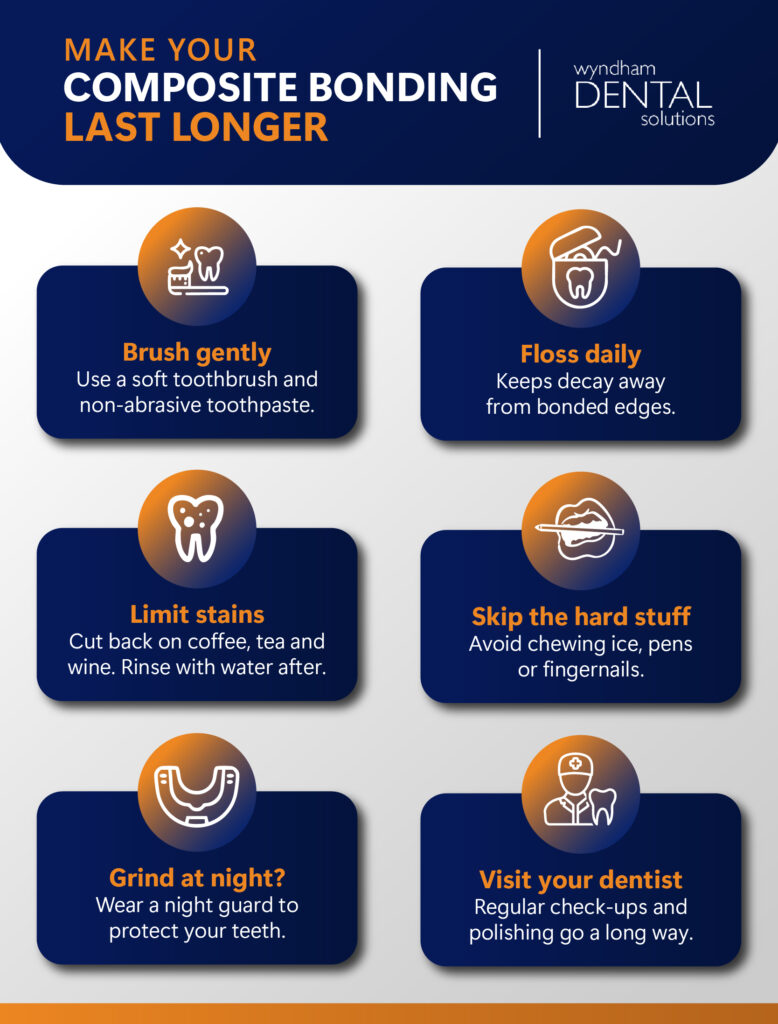How Long Does Composite Bonding Last?

If you’ve ever had a chipped tooth or wished you could close the small gap in your smile without getting braces, chances are you’ve heard of composite bonding. It’s one of the easiest and most affordable ways to fix minor imperfections in your teeth, and it’s often done in a single visit. All this rush when it comes to treatment… but how long can you actually expect it to last?
The short answer is anywhere from four to eight years. Sometimes it can be longer, with some suggesting it may last up to a decade. And sometimes a little less with just two to three years. It all comes down to upkeep in the end. How well you look after your teeth says a lot about the durability of your composite bonding.
What is composite bonding?
Composite bonding is a cosmetic dental treatment where a tooth-coloured resin is shaped and polished to improve the look of your teeth. It’s commonly used to repair chips, cracks, uneven edges or discolouration. It’s also great for closing small gaps between teeth or making them look more symmetrical.
The material used is similar to what’s used in tooth-coloured fillings. It is applied in layers, hardened with a special light, and shaped to match the rest of your tooth. There’s no need to shave down your teeth or get injections unless the area being worked on is near a nerve or a sensitive spot. Truly an easy fix for those minor flaws in your smile.
What affects how long bonding lasts?
Getting composite bonding done isn’t a one-size-fits-all situation. Some people might get ten years out of it, while others might need a touch-up much sooner.
The lifespan of composite bonding depends on a few key things:
- Where it is done
Bonding on your front teeth generally lasts longer than bonding on your molars. That’s simply because your front teeth aren’t doing the heavy work of chewing. If you’ve had bonding done on your back teeth, expect more wear and tear over time.
- Your daily habits
Biting your nails, chewing on pens, or using your teeth to open things can damage bonding pretty quickly. Grinding your teeth at night is another major culprit. If you’re someone who clenches or grinds, you might want to consider a night guard.
- The food and drinks you consume
Composite resin is more porous than enamel, which means it can stain more easily. Drinking a lot of coffee, tea or red wine, or smoking, can cause discolouration over time. Unlike your natural enamel, you can’t whiten bonded areas, so if staining sets in, you’ll need to replace or re-polish the bonding.
- How well you care for your teeth
Good oral hygiene plays a big role in how long your bonding lasts. Brushing twice a day, flossing daily and seeing your dentist regularly can help prevent decay around the bonded area and keep everything intact for longer.
Signs that your bonding might need replacing
Bonding doesn’t suddenly fall off one day. Usually, you’ll start to notice little changes that let you know it’s time to get it checked out. These include:
- Chips or cracks in the bonded area
- Transparency in the bonding
- Stains or yellowing that won’t go away with brushing
- Rough edges that weren’t there before
- A change in how your bite feels
- Discomfort or sensitivity in the bonded tooth
If you notice any of these, it’s a good idea to book an appointment to visit your dentist. In many cases, small issues can be fixed without needing to redo the whole thing. Wyndham Dental is here to help you bring it back to shape.

Can composite bonding be repaired?
Yes, and that’s one of the benefits of it. If a small piece chips off, our dentists can usually fix it without removing the whole thing. They can also polish it if it becomes dull or slightly stained.
It’s much easier (and cheaper) to repair than other cosmetic options like veneers or crowns.
How does bonding compare to other treatments?
If you’re deciding between bonding and something like veneers, here’s a quick comparison:
- Composite bonding is quicker, more affordable and doesn’t involve removing enamel. It’s a great option for minor fixes.
- Veneers are more durable and resistant to staining, but they require some enamel to be removed and cost more upfront.
- Crowns are even stronger but usually reserved for more severe damage.
- Teeth whitening is great for an overall colour boost, but it won’t fix chips or reshape your teeth.
Bonding is a great option if you’re not ready to commit to something more permanent or invasive, or if you just want to make a few subtle changes.
Should you eventually switch to veneers?
Some people who start with bonding end up switching to veneers later on. That usually happens when they want something more long-lasting or if they’re after a more dramatic transformation.
Others stick with bonding for years, simply getting touch-ups when needed. It really depends on your goals, your budget and how much maintenance you’re happy to keep up with.
Composite bonding can last a good few years when looked after properly. It’s not meant to be a permanent fix, but it’s affordable, flexible and easy to repair. Whether you’ve already had bonding or are thinking about it, the key to making it last is simple: look after your teeth, avoid damaging habits and stay on top of your checkups.
If you’re unsure about how long your bonding will last or whether it’s time for a touch-up, your best bet is to have a chat with a dentist. Our experienced dentists at Wyndham Dental provide expert advice on all aspects of oral care and will assess your smile to inform you of the next steps.
Contact our friendly team today to book your appointment.
